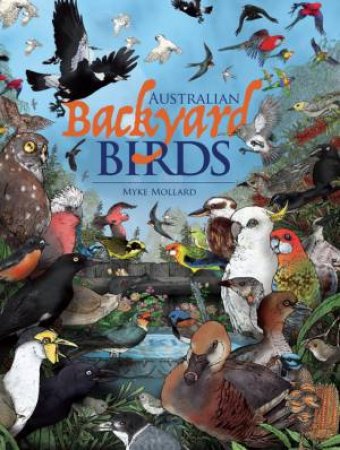Australian backyard birds by Myke Mollard

I have been duped! As I look out my window and see a dozen little brown fairy wrens pecking amongst the dry winter grass for morsels, I thought that some male was going to have a great choice for a harem because I'd learned that that's what they have - although said male was nowhere in sight. But I may have been mistaken because I have just discovered that most of the year, the males look like females in their nondescript brown plumage and only change into their stunning bright blue dress when they are ready to breed! Given it's been such a cold mountain winter this year, that time is obviously not yet. And all those that I thought were females, might have disguised identities.
And that information is just on the title page of this amazing book - along with the author's own observation of how he watch a pair trick a metre-long tiger snake up a tree - so I was eager to discover what other secrets might lie within. Mollard himself is an avid birdwatcher - aka a "twitcher" to some - and in this stunning release, his focus is not the spectacular birds of prey or those that roam the rural and remote regions of our country, but those that frequent city backyards - the "adaptive, resourceful and ingenious creatures [that} have not only become used to humans and human environments, but are positively thriving...[using] our buildings to rest and roost, [foraging] for grubs and worms, spiders and insects in our veggie patches, [bathing] in our water buckets, gutters, fishponds and birdbaths".
Unsurprisingly, in a land as vast and diverse as Australia, even though the big cities might look the same, there are different climates, vegetation, landscapes and landshapes that determine what non-human life dwells there so the book is organised according to states and territories with catchy titles like "Common Street Thugs" offering intriguing information alongside Mollard's distinctive detailed illustrations. With so much interest in Satin Bowerbirds since Aura Parker's Bowerbird Blues was the NSS title for 2024 (and sequels Bowerbird Brood and Bowerbird Bloom) it was fascinating to discover that these are not unusual in shady Canberra gardens - perhaps in more established, affluent suburbs than those I lived in - although many of those identified in the "parliament of birds" illustration are very familiar. With over 150 species that are commonly found in local parks and gardens across the nation, there are bound to be some that students will recognise and be eager to find out more. Teaching notes will help guide their investigations, as well as encourage them to probe further including discussing Einstein's belief that 'Our task must be to free ourselves by widening our circle of compassion to embrace all living creatures and the whole of nature in its beauty' by identifying what the threats to local populations are and what can be done to help species and attract them to the urban environment.
With endpapers that identify the various regions, migratory paths, and other significant material, this is yet another of Mollard's masterpieces that have intrigued me with their attention to detail that is so accessible to its intended audience of younger, independent readers who have an interest that has the potential to be more.
A CBCA Notable for the Eve Pownall Award in 2024, this book may well be in your collection, but perhaps it is time to be the central focus for the upcoming annual Aussie Bird Count or any other citizen science project happening in your location.
Themes: Birds.
Barbara Braxton